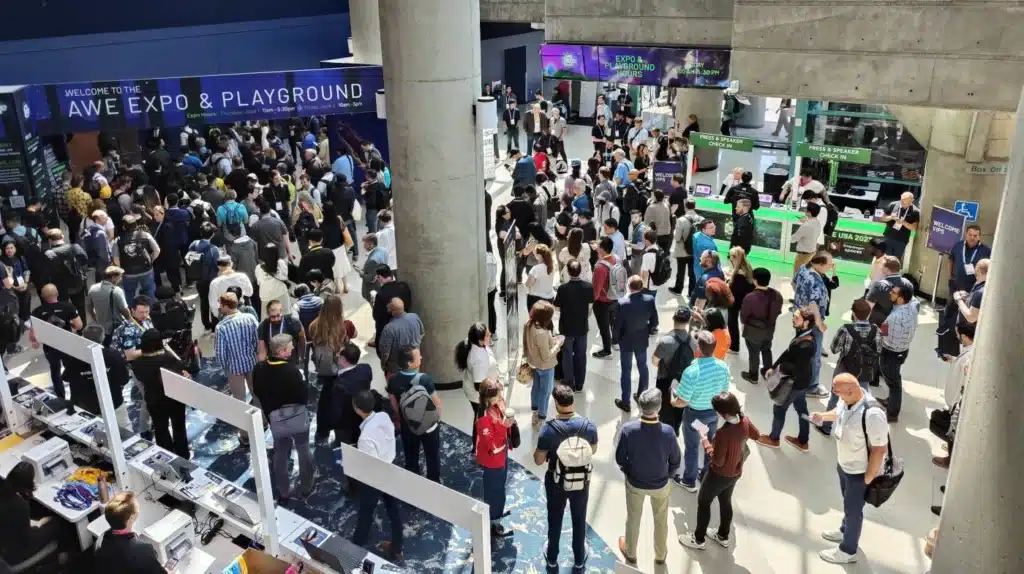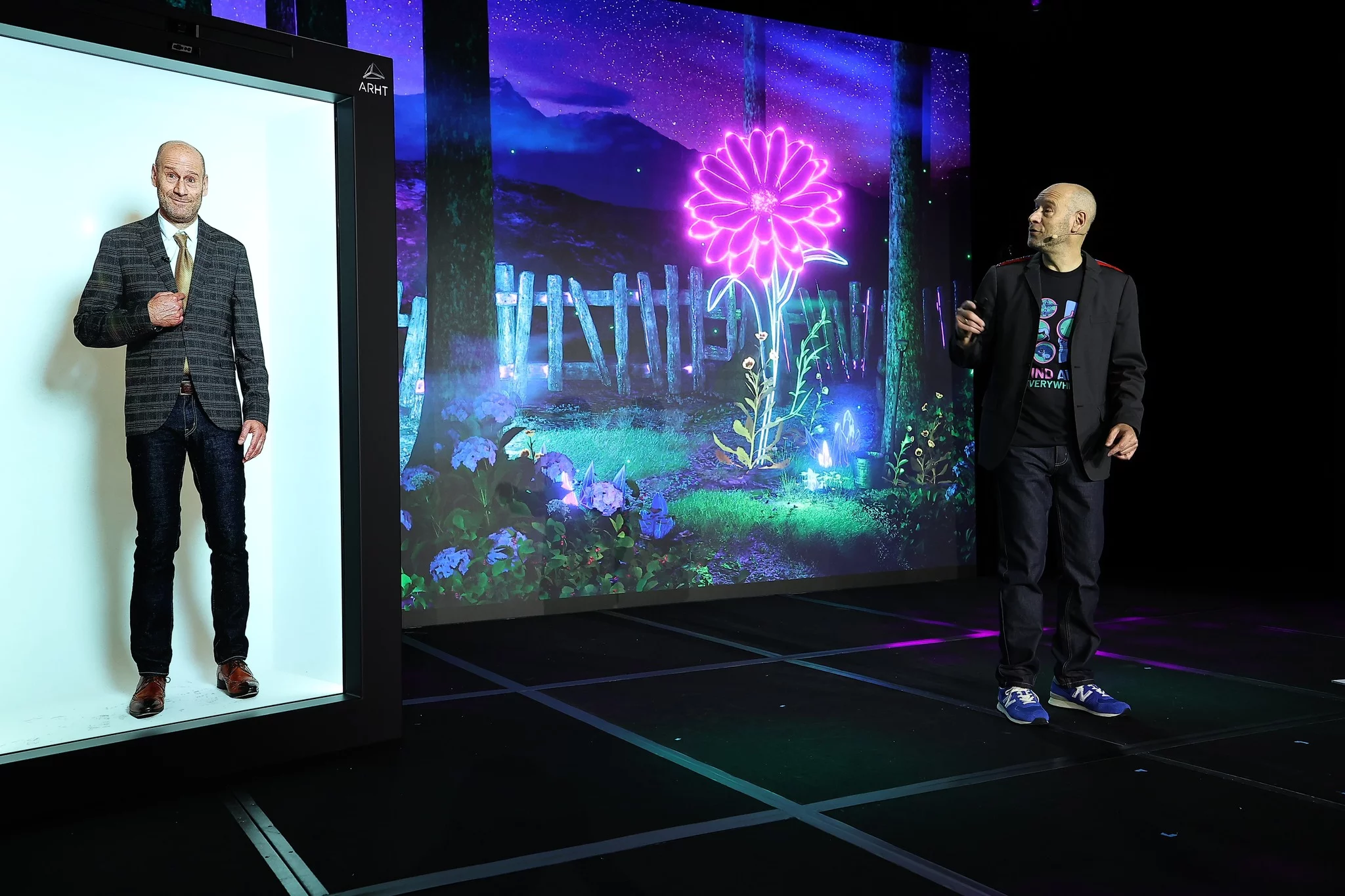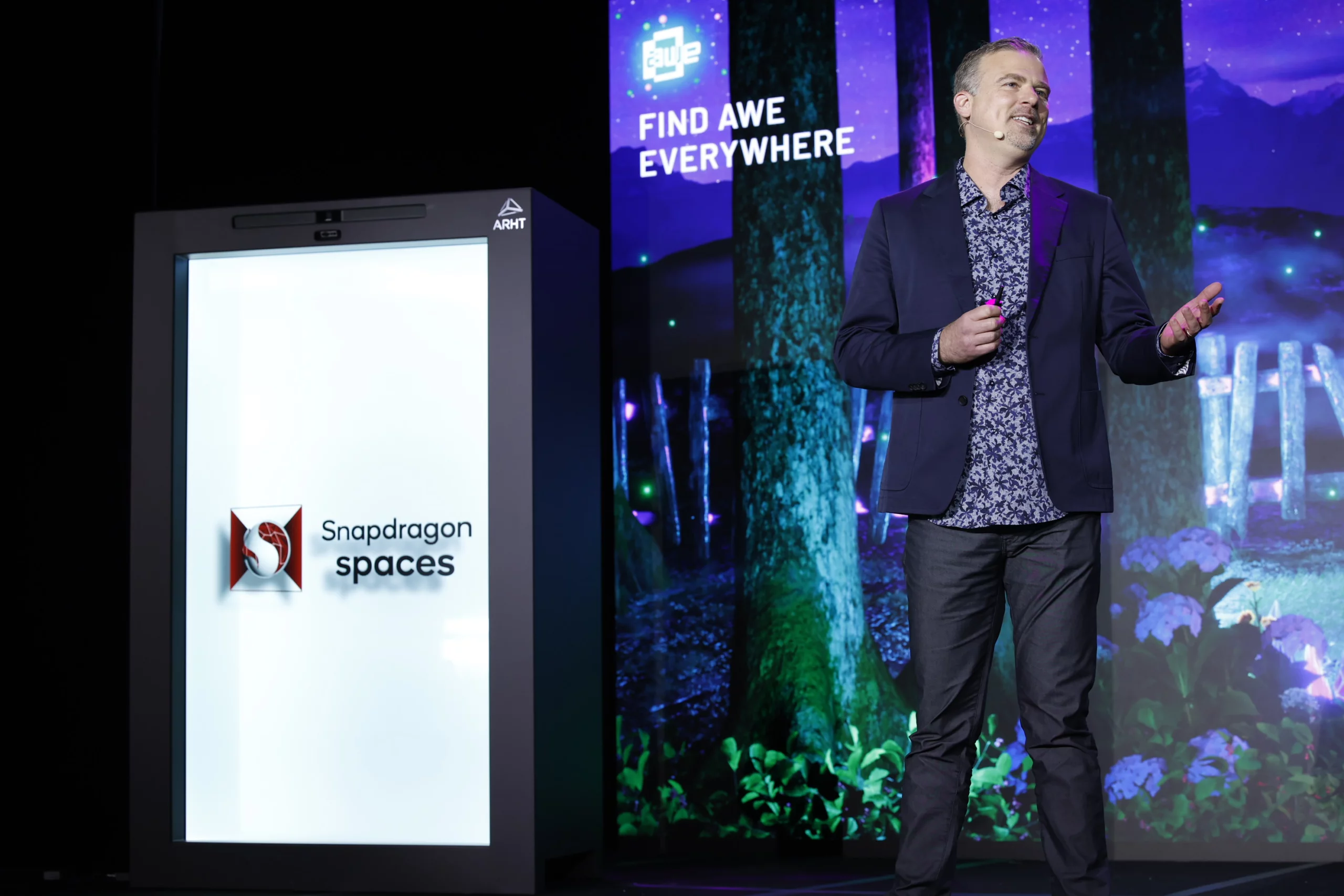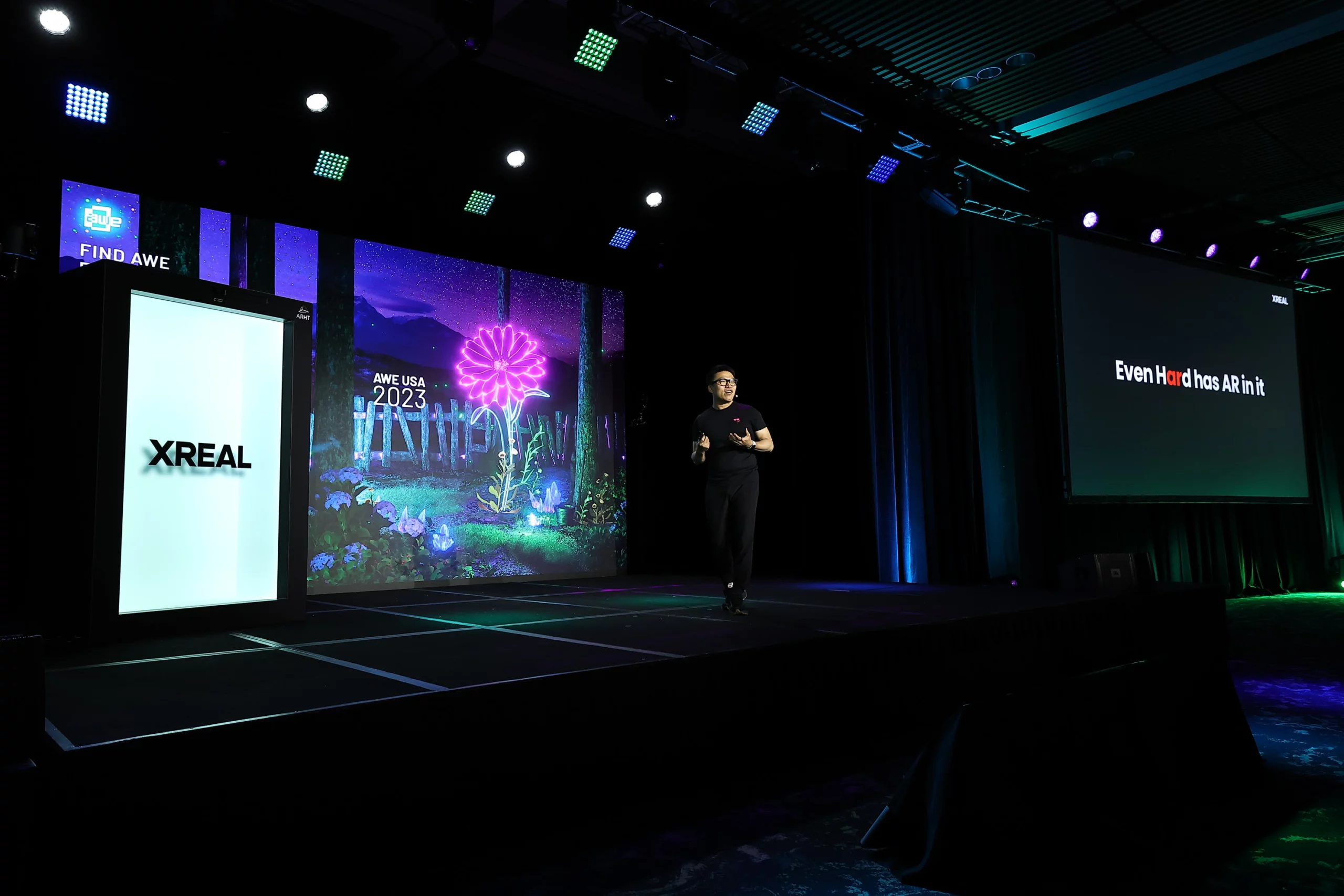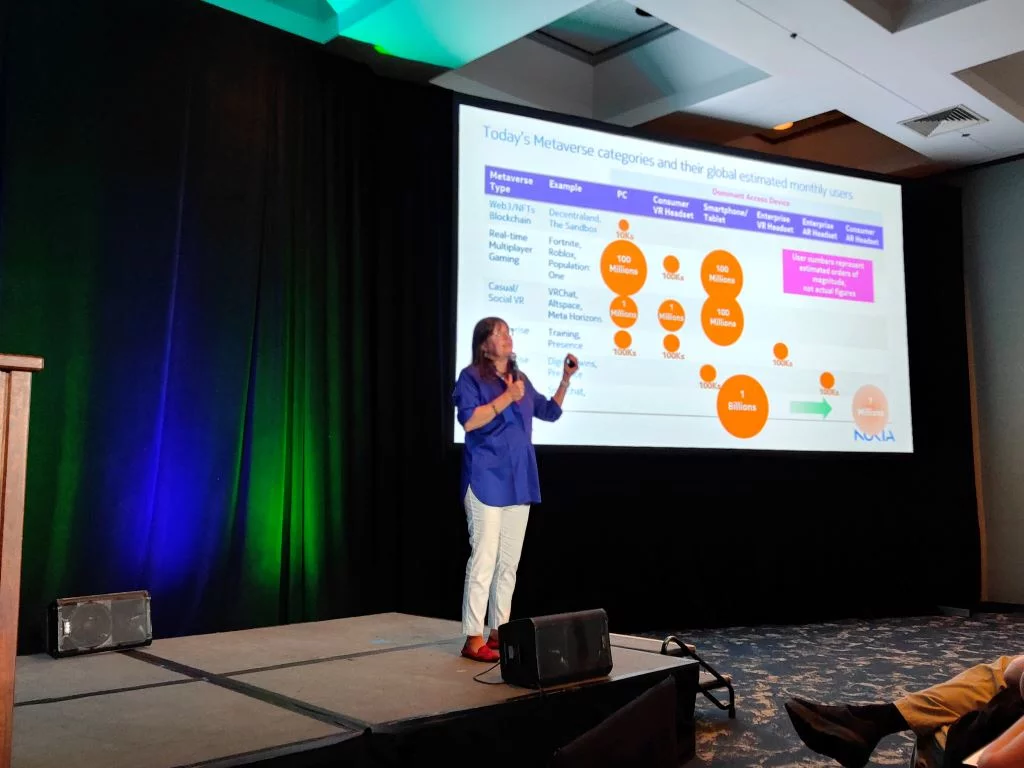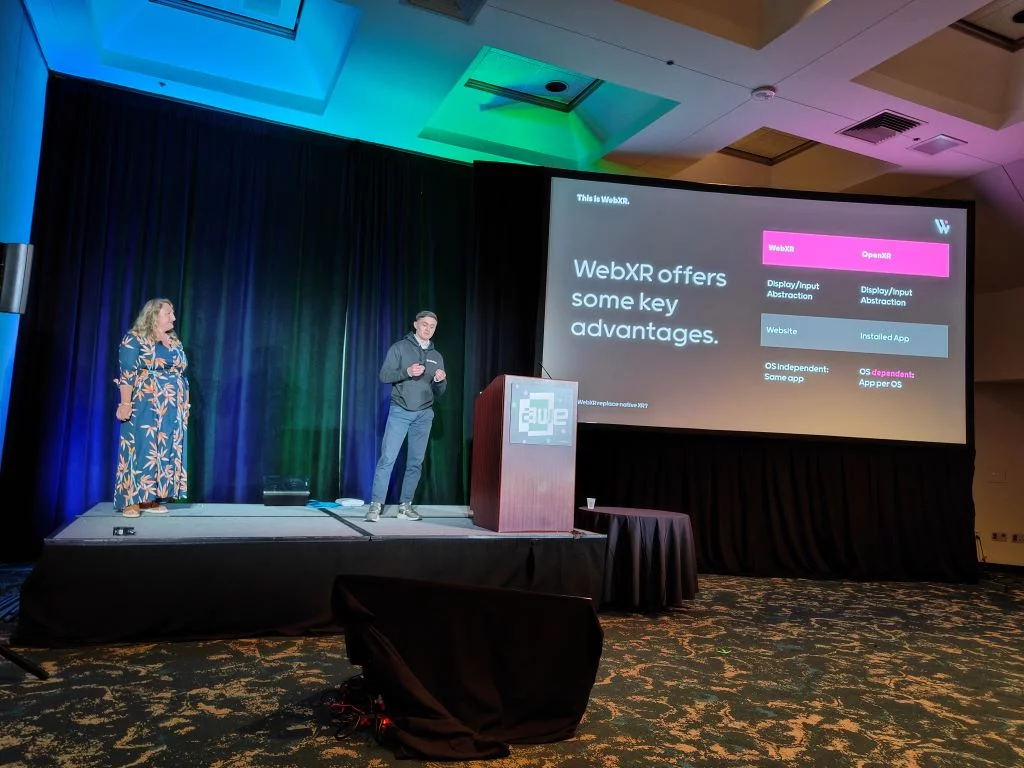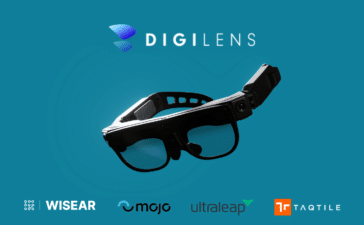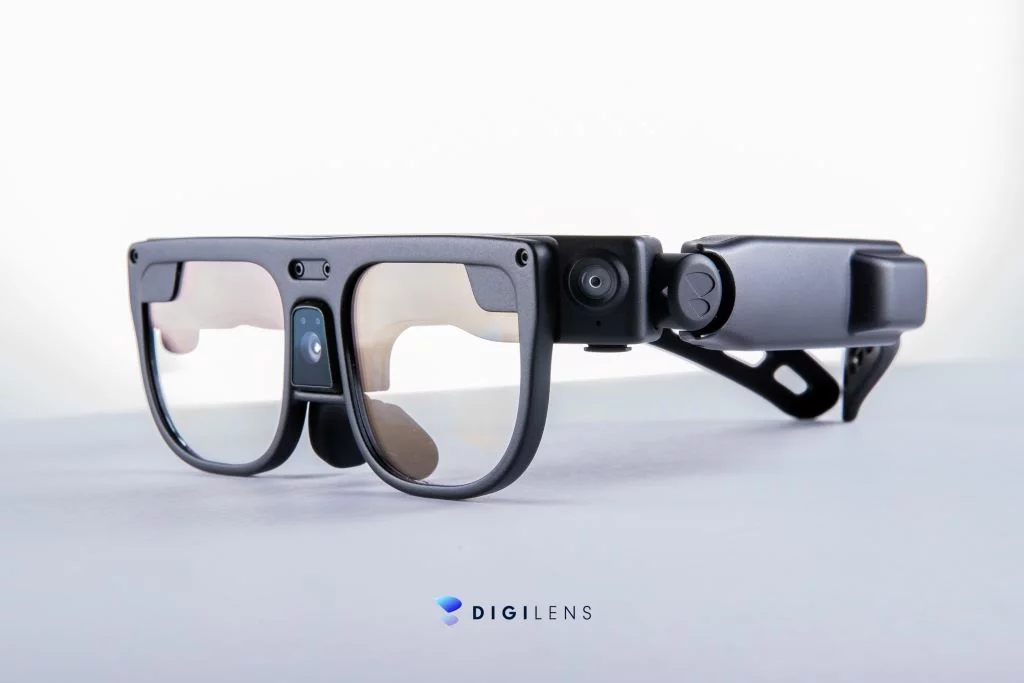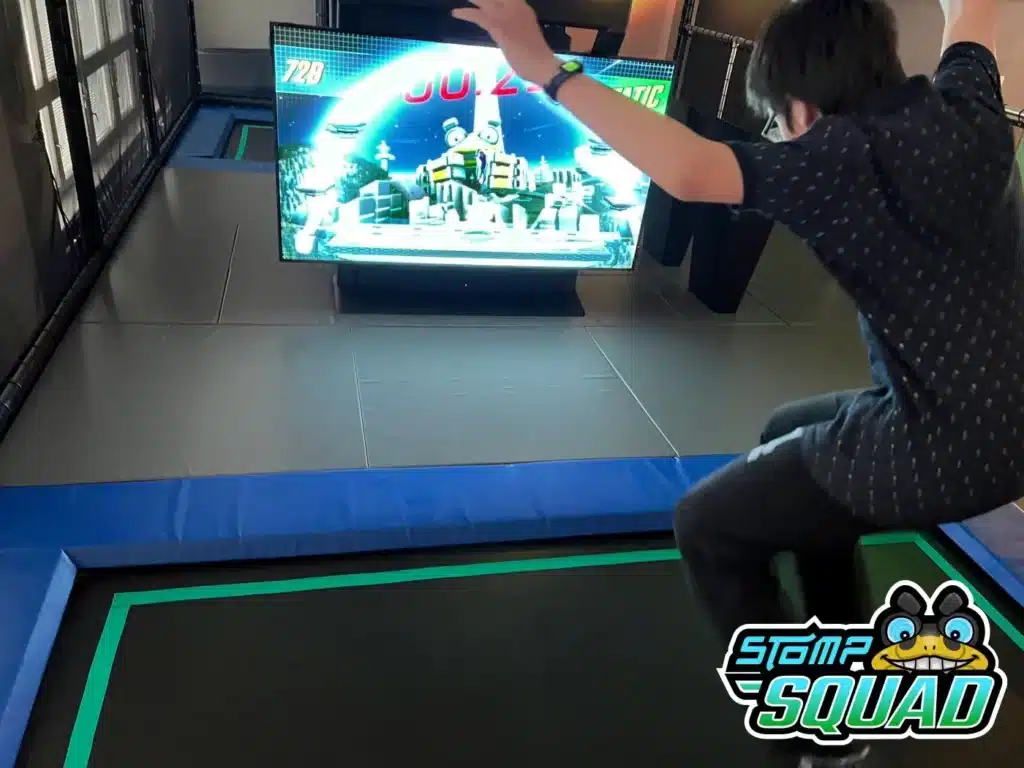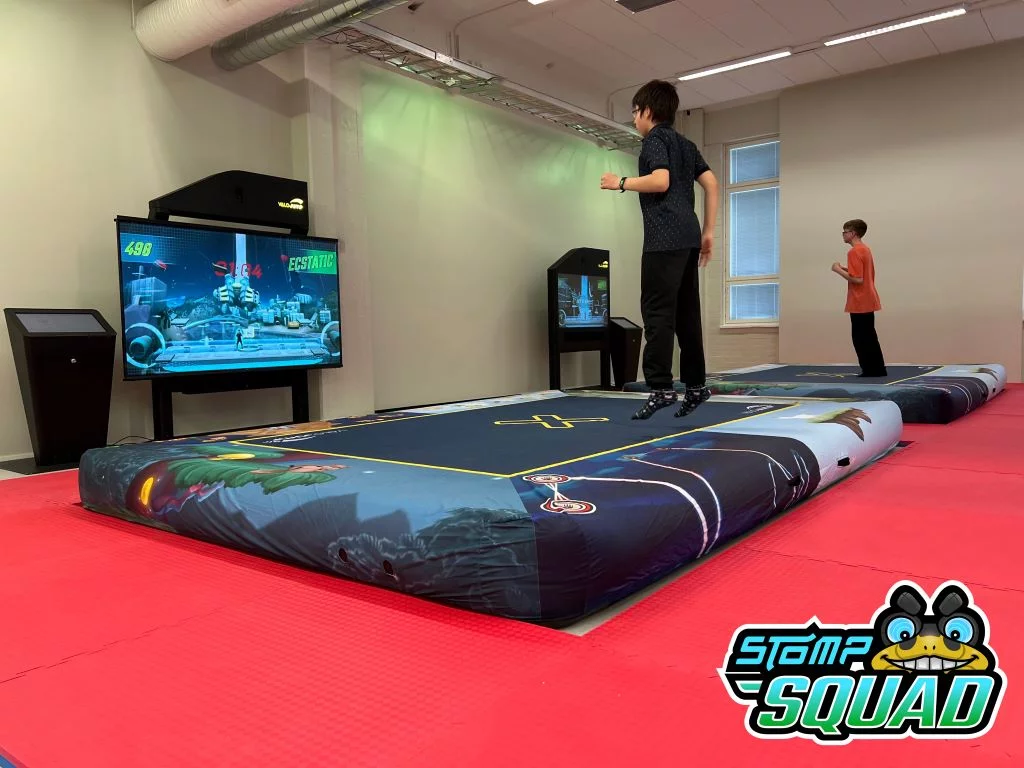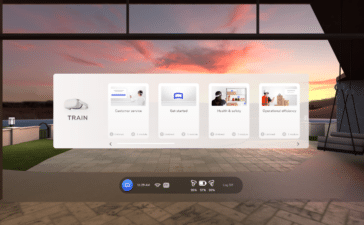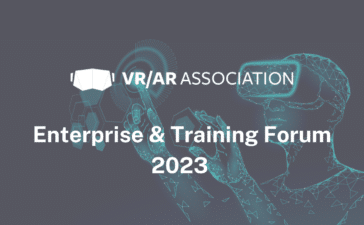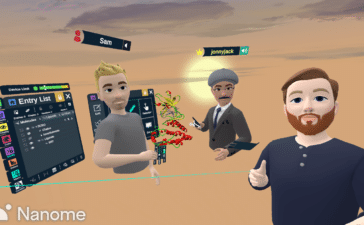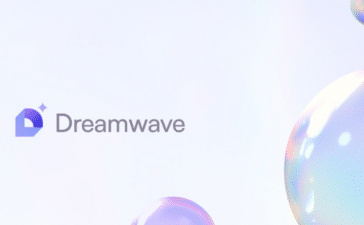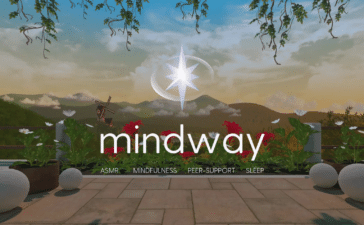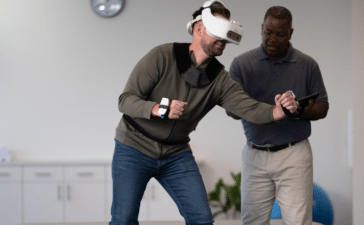AWE USA 2023 Day Two: More Keynotes, More Panels, and the Open Expo Floor
The second day of AWE is the day that the expo floor opens. That is always thrilling, and we’ll get there, but first – more keynotes and conversations.
AWE Day Two Keynotes
Day One kickstarted the keynotes, but AWE Day Two saw exciting presentations and announcements from Magic Leap and Niantic. Both affirmed a theme from the day before: meaningful XR is already here.
Magic Leap: Let’s Get to Work
“The vision of AR that some legacy tech companies are promising is still years out, is not years or months or days out,” Magic Leap CEO Peggy Johnson said in her keynote. “The small team at Magic Leap has made something that many larger companies are still struggling to achieve.”
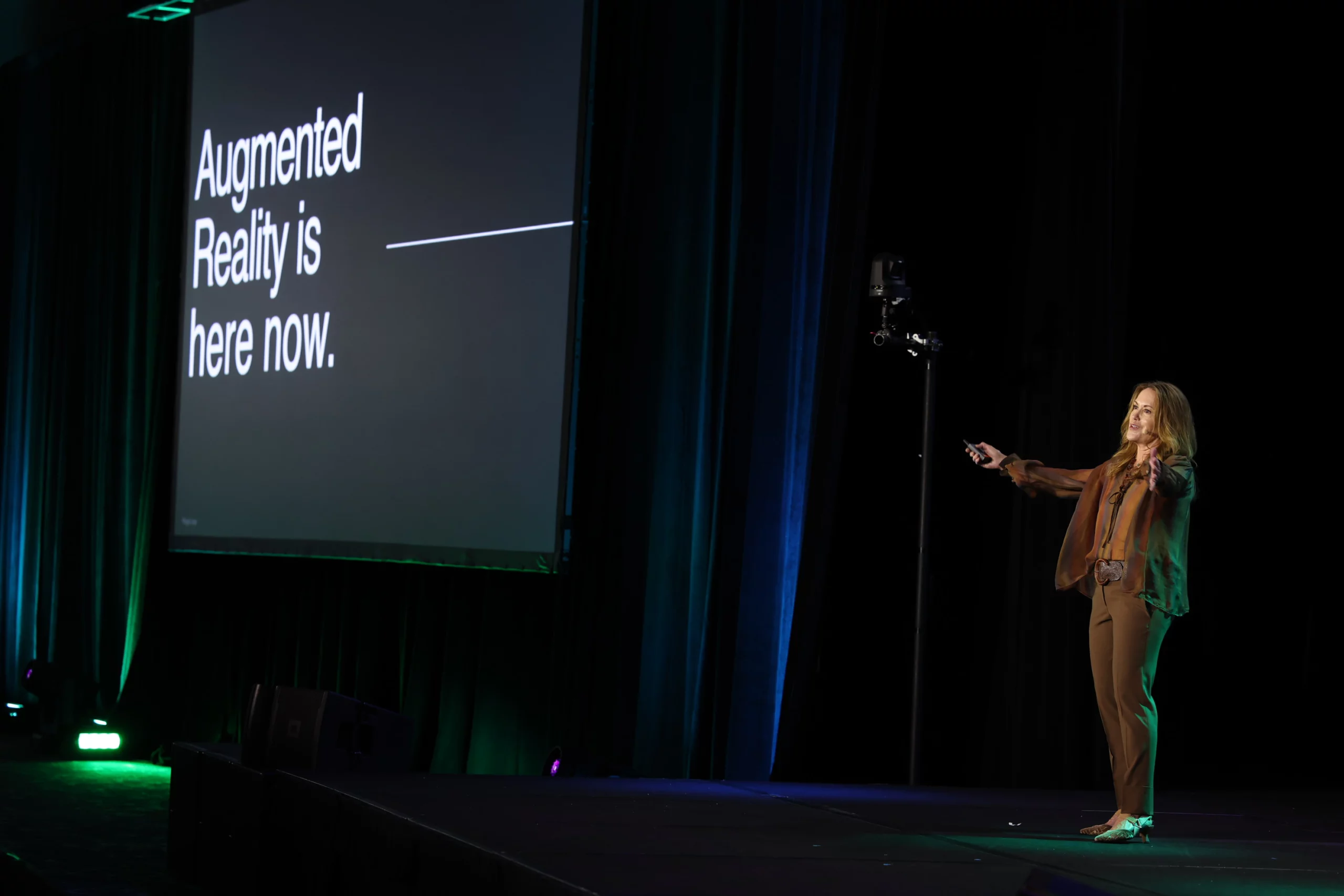
Johnson also continued another theme from AWE Day One: AI and XR aren’t in competition – they help each other. Inbar’s opening talk included a line that quickly became a motto for almost the whole event: “XR is the interface for AI.”
“I honestly believe AR systems are going to become the endpoints for a lot of AI,” said Johnson. “The ability to provide contract input and get contextual output will really be a game changer.”
Magic Leap’s big announcement wasn’t to do with AI, but it will still be thrilling to developers: an Unreal Engine plugin is coming in August.
“AR Everywhere” With Niantic
While enterprise companies and hardware manufacturers are still struggling with adoption to since degree, few companies have done as much for AR consumer adoption as Niantic.

In his AWE keynote, “Empowering AR Everywhere”, Niantic Senior Vice President of Engineering, Brian McClendon, laid out a number of major updates coming to the company – as well as coming to or through 8th Wall.
First, ARDK 3.0 will allow developers using Niantic tools to also use outside AR asset libraries. It will also enable a QR code-triggered “lobby system” for multi-user shared AR experiences. The updated ARDK will enter a beta phase later this month. A new maps SDK compatible with Unity is also coming to 8th Wall.
Further, 8th Wall’s “Metaversal Deployment” announced at AWE 2021 is now compatible with mixed reality via Quest 2, Quest Pro, “and probably all future MR headsets.”
Big Picture Panel Discussions
One of the things that really makes AWE special is its ability to bring together the industry’s big thinkers. A number of insightful panel discussions from Day Two explored some of the biggest topics in XR today.
XR’s Inflection Point
The panel discussion “How Immersive Storytelling Can Deepen Human Understanding of Critical Issues” brought together Unity CEO John Riccitiello, journalist Ashlan Cousteau, and TRIPP CEO and co-founder Nanea Reeves. The talk included further affirmations that, contrary to some media pieces, XR as an industry is thriving.

“I now cancel what I said seven years ago about this not being a good time to build a business in this space,” said Riccitiello. “We’re at a time right now where it makes a lot of sense to look forward with optimism around XR. … Companies are born around technology transitions.”
Reeves echoed the sentiment, but included some of the cautious caveats expressed by XR ethicist Kent Bye during a panel discussion yesterday.
“We’re at such an interesting point of technology and the evolution of it, especially with AI and XR,” said Reeves. “What’s the next level of storytelling and what should we be aware of as we bring AI into it?”
Building Open Standards for the Metaverse
The good news is that the metaverse isn’t dead. The bad news is that it arguably hasn’t been born yet either. One of the most important features of the metaverse is also one of its most elusive.
It was also the crux of a panel discussion bringing together XR Safety Initiative founder and CEO Kavya Pearlman, XRSI Advisor Elizabeth Rothman, and Khronos Group President Neil Trevett, moderated by Moor Insights and Strategy Senior Analyst Anshel Sag.

“Whichever way you come to the metaverse, you need interoperability,” said Trevett. “It’s foundational.”
The panel also addresses the lasting and fleeting effects of the wave of attention that has seemingly passed over the metaverse.
“We go through these hype cycles and bubbles,” said Rothman. “There are always technological innovations that come out of them.”
The panel also addressed AI, an overarching theme of the conference. However, the panel brought up one concern with the technology that had not been addressed elsewhere.
“This convergence has a way more visceral impact on children’s brains even than social media,” said Pearlman.
So far, the “solution” to this problem has been for content publishers to age-restrict experiences. However, this approach has crucial shortcomings. First, most approaches to age restrictions aren’t foolproof. Second, when they are, this measure excludes young users rather than protecting them.
“We run the risk of regulating children right out of the metaverse,” said Rothman. “We need to strike a balance.”
Hitting the AWE Floor
I first started covering AWE during the pandemic when the entire conference was virtual. AWE is a lot more fun in-person but, practically speaking, the demos are the only component that can’t really happen remotely.
Meeting Wol
I actually met Wol in the Niantic Lounge before the very first session on Day One. While this is where arranging this content makes sense to me, Wol was possibly my first impression of AWE. And it was a good one. But wait, who’s Wol?

Wol is a collaboration between 8th Wall, Liquid City, and InWorld AI. He’s an artificially intelligent character virtually embodied as an owl. His only job is to educate people about the Redwood Forest but he’s also passionate about mushrooms, fairies, and, well, you just have to meet him.
“Wol has a lot of personal knowledge about his own life, and he can talk to you about the forest through his own experience,” explained Liquid City Director Keiichi Matsuda. “Ultimately, Wol has a mind of its own and we can only provide parameters for it.”

I met Wol through the Quest Pro in passthrough AR via a portal that appeared in the room directly into the Redwoods – and, now that I think about it, this was the day before Niantic announced that 8th Wall supported Quest Pro MR. In any case, the whole experience was magical, and I can’t wait to get home and show it to the family.
Visiting Orlando via Santa Clara
Largely thanks to a group called the Orlando Economic Partnership, Orlando is quickly becoming a global epicenter of metaverse development. Just one of their many initiatives is an 800-square-mile virtual twin of the Orlando area. The digital twin has its own in-person viewing room in Orlando but it also exists in a more bite-size iteration that runs on a Quest 2.
“The idea was to showcase the entire region – all of its assets in terms of data points that we could present,” explained the OEP’s Director of Marketing and Communications Justin Braun. “It’s going to become a platform for the city to build on.”
I was able to see at AWE featured photorealistic 3D models of Orlando landmarks, complete with informational slides and quiz questions. The full version, which took 11 months, is a lot more fully featured. It just doesn’t fit in Braun’s backpack.
“At some point, this will be able to do things that are beneficial for the city and its utilities, like shower power outages,” said the OEP’s Chief Information Officer David Adelson. “It’s community-driven.”
Gathering Around the Campfire
I opened by saying that demos can’t be done remotely. I remotely demoed Campfire recently, but that was their desktop view. Campfire also offers tabletop and room-scale 3D interactions that require the company’s custom-made headset and markers. I got to try these solutions out hands-on when I reconnected with CEO and co-founder Jay Wright on the AWE floor.
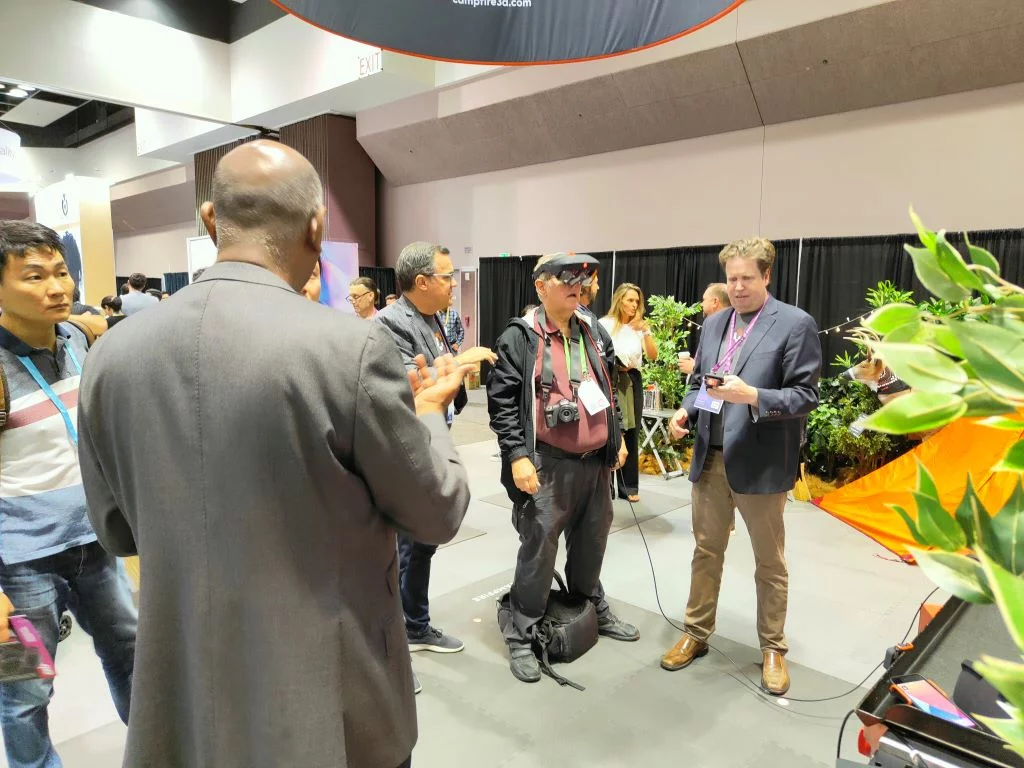
“The perception system is designed to do one thing very well, and that’s to make multi-user AR as high-fidelity as desktop,” said Wright. And they’ve done it.
Models and mockups that I viewed in mixed reality using Campfire’s hardware were beautifully rendered. The internet connectivity at AWE is notoriously spotty and, while the controller disconnected a few times, the display never skipped a beat.
Wright demonstrated the visor that switches Campfire from MR to VR on a virtually reconstructed art museum that I could view from above in a “dollhouse mode” or travel through in a 1:1 model. In addition to showcasing more hardware and software ease-of-use, it might have been the most graphically impressive showcase I’ve seen from XR hardware ever.
The Lenovo VRX
With Lenovo ThinkReality’s new headset announced the day before AWE started, this might be the record for the shortest passage of time between a headset releasing and my putting it on – and it’s all thanks to ARPost’s longtime Lenovo contact Bill Adams.
“We think we have one of the best passthrough headsets and most comfortable headsets in the industry,” said Adams, who made a gentleman’s wager that I would (finally) be able to see my notes through the Lenovo VRX.
I couldn’t read my writing, but I could tell where the writing was on the page – which, honestly, is enough. Having tried the same experiment on the Quest Pro earlier that day, I can back up what Adams said about the headset’s passthrough quality.
As for comfort, ditto. The headset features a removable overhead strap, but it was so comfortable that I forgot that the strap was there anyway. Switching from VR to passthrough is a simple button press.
Catching Up With Snap
The average user can have a great AR experience with just a phone, and the average creator can make a really advanced experience without creating their own app, according to Snap Senior Product Communications Manager Cassie Bumgarner.

“There’s a lot of chatter on the hardware front, but what we want to show is that there’s so much more left to unlock on the mobile front,” said Bumgarner.
A Snap Lense made with QReal uses AI to identify LEGO bricks in a tub. A quick scan, and the lens recommends small models that can be made with the available pieces. Bumgarner and I still get the fun of digging out the pieces and assembling them, and then the app creates a virtual LEGO set to match our creation – in this case, a bathtub to go with the duck we made.
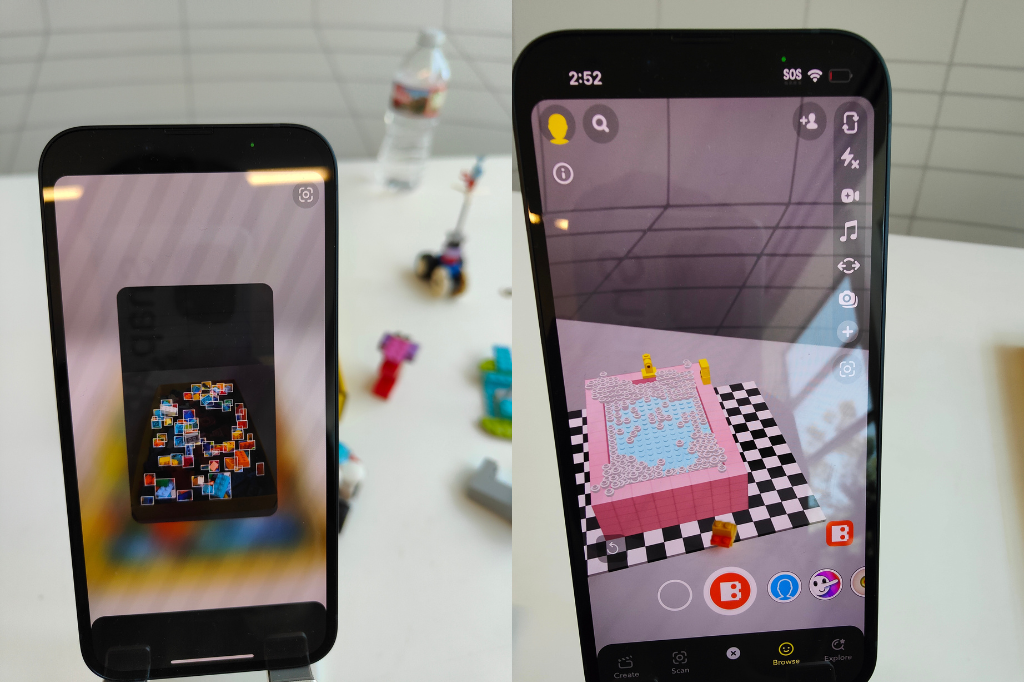
Of course, Snap has hardware too. On display at AWE, the company showed off the virtual try-on mirrors debuted at the Snap Partner Summit that took place in April.
One More Day of AWE
Two days down and there’s still so much to look forward to from AWE. The expo floor is still open tomorrow. There are no more keynotes, but that just means that there’s more time for panel discussions and insightful conversations. And don’t think we forgot about the Auggies. While most of the Auggies were awarded last evening, there are still three to be awarded.
AWE USA 2023 Day Two: More Keynotes, More Panels, and the Open Expo Floor Read More »
